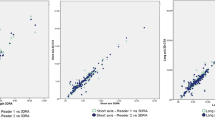Abstract
We report our findings associated with the differential diagnosis of infundibular dilation (ID) versus a small intracranial aneurysm using three-dimensional rotational angiography with volume rendering (3DRA + VR). Angiographic findings associated with IDs found via two-dimensional digital subtraction angiography (2D-DSA) or 3DRA + VR were reviewed for 138 consecutive patients with known or suspected aneurysms. Two readers independently evaluated the results of 2D-DSA and 3DRA + VR according to the same diagnostic criteria. We also evaluated the ability of 3D-DSA to show the spatial relation between IDs and anterior choroidal (AchA)/posterior communicating (PcomA) arteries. 2D-DSA and 3DRA + VR found 41 and 48 IDs, respectively. 2D-DSA missed five AchA and two PcomA IDs. 2D-DSA was significantly inferior to 3DRA + VR for displaying the spatial relation between IDs and AchA/PcomA (P = 0). Thus, 3DRA + VR provides more useful information for distinguishing IDs from aneurysms. The superiority of 3DRA + VR might be because of its ability to display the spatial relation between IDs and AchA/PcomA.


Similar content being viewed by others
References
Ebina K, Ohkuma H, Iwabuchi T (1986) An angiographic study of incidence and morphology of infundibular dilation of the posterior communicating artery. Neuroradiology 28:23–29
Salyzman GF (1959) Infundibular widening of the posterior communicating artery studied by carotid angiography. Acta Radiol 51:415–421
Taveras LM, Wood EH (1976) Diagnostic neuroradiology, 2nd edn. Williams and Wilkins, Baltimore, pp 584–587
Kubota T, Niwa J, Tanigawara T et al (2000) Differential diagnosis between aneurysm and infundibular dilatation in the IC-PC region with 3D-CTA. No Shinkei Geka (Tokyo) 28:31–39
Li MH, Li YD, Tan HQ et al (2011) Contrast-free MRA at 3.0 T for the detection of intracranial aneurysms. Neurology 77:667–676
Kato Y, Katada K, Hayakawa M et al (2001) Can 3D-CTA surpass DSA in diagnosis of cerebral aneurysm? Acta Neurochir (Wien) 143:245–250
Adams WM, Laitt RD, Jackson A (2000) The role of MR angiography in the pretreatment assessment of intracranial aneurysms: a comparative study. AJNR Am J Neuroradiol 21:1618–1628
Satoh T, Onoda K, Tsuchimoto S (2003) Visualization of intraaneurysmal flow patterns with transluminal flow images of 3D MR angiograms in conjunction with aneurysmal configurations. AJNR Am J Neuroradiol 24:1436–1445
Satoh T, Omi M, Ohsako C et al (2006) Differential diagnosis of the infundibular dilation and aneurysm of internal carotid artery: assessment with fusion imaging of 3D MR cisternography/angiography. AJNR Am J Neuroradiol 27:306–312
Endo S, Furuichi S, Takaba M et al (1995) Clinical study of enlarged infundibular dilation of the origin of the posterior communicating artery. J Neurosurg 83:421–425
Hochmuth A, Spetzger U, Schumacher M (2002) Comparison of three-dimensional rotational angiography with digital subtraction angiography in the assessment of ruptured cerebral aneurysms. AJNR Am J Neuroradiol 23:1199–1205
Kawashima M, Kitahara T, Soma K et al (2005) Three-dimensional digital subtraction angiography vs two-dimensional digital subtraction angiography for detection of ruptured intracranial aneurysms: a study of 86 aneurysms. Neurol India 53:287–289
Van Rooij WJ, Peluso JP, Sluzewski M et al (2008) Additional value of 3D rotational angiography in angiographically negative aneurysmal subarachnoid hemorrhage: how negative is negative? AJNR Am J Neuroradiol 29:962–966
Van Rooij WJ, Sprengers ME, de Gast AN et al (2008) 3D rotational angiography: the new gold standard in the detection of additional intracranial aneurysms. AJNR Am J Neuroradiol 29:976–979
Menke J, Larsen J, Kallenberg K (2011) Diagnosing cerebral aneurysms by computed tomographic angiography: meta-analysis. Ann Neurol 69:646–654
Westerlaan HE, van Dijk JM, Jansen-van der Weide MC et al (2011) Intracranial aneurysms in patients with subarachnoid hemorrhage: CT angiography as a primary examination tool for diagnosis: systematic review and meta-analysis. Radiology 258:134–145
Martins C, Macanovic M, CostaeSilva IE et al (2002) Progression of an arterial infundibulum to aneurysm: case report. Arq Neuropsiquiatr 60:478–480
Nashimoto T, Saito T, Kurashima A et al (2009) Rupture of a small aneurysm originating from an infundibular dilatation: case report. Brain Nerve 61:1177–1181
Patrick BD, Appleby A (1983) Infundibular widening of the posterior communicating artery progressing to true aneurysm. Br J Radiol 56:59–60
Takahashi C, Fukuda O, Hori E et al (2006) A case of infundibular dilatation developed into an aneurysm and rupturing after the rupture of an aneurysm 10 years ago. No Shinkei Geka 34:613–617
Koike G, Seguchi K, Kyoshima K et al (1994) Subarachnoid hemorrhage due to rupture of infundibular dilation of a circumflex branch of the posterior cerebral artery: case report. Neurosurgery 34:1075–1077
Wiebers DO, Whisnant JP, Huston J 3rd et al (2003) Unruptured intracranial aneurysms: natural history, clinical outcome, and risks of surgical and endovascular treatment. Lancet 362:103–110
Acknowledgments
This study was supported by the National Natural Scientific Fund of China (contract no. 30570540), the Shanghai Important Subject Fund of Medicine (contract no. 05 III 023), and the Program for Shanghai Outstanding Medical Academic Leader (contract no. LJ 06016).
Conflict of interest
We declare that we have no conflict of interest.
Author information
Authors and Affiliations
Corresponding authors
Electronic supplementary material
Below is the link to the electronic supplementary material.
Rights and permissions
About this article
Cite this article
Shi, WY., Li, YD., Li, MH. et al. Differential diagnosis of infundibular dilation versus a small aneurysm of the internal carotid artery: assessment by three-dimensional rotational angiography with volume rendering. Neurol Sci 34, 1065–1070 (2013). https://doi.org/10.1007/s10072-012-1182-y
Received:
Accepted:
Published:
Issue Date:
DOI: https://doi.org/10.1007/s10072-012-1182-y




